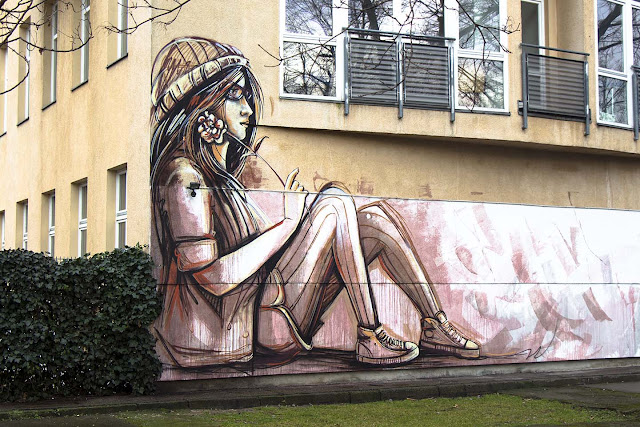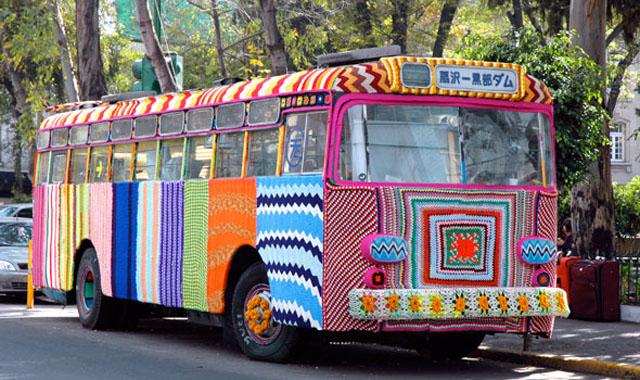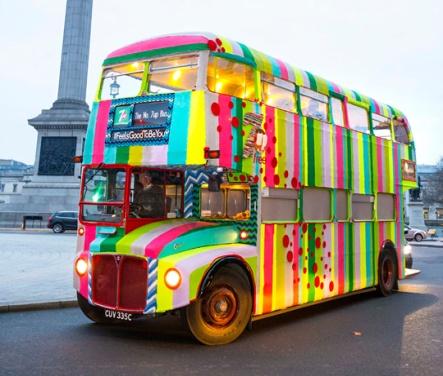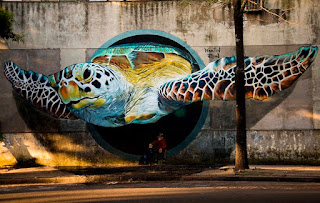http://bestreetart.blogspot.de/2015/10/invader-invader-is-prettyfamous-french.html
12/10/2015
Bombing
Bombing
-> Underground-Bombing
-> Train-Bombing
Like
in the movie was said Bombing is a fast, on quantity based, illegal
graffiti.
For
the sprayers it’s important that it is illegal, because if it
wouldn’t, it could be done by everyone.
Also
Spraying is more important for them than the rules they break.
A
very famous bomber-crew is Moses and Taps
12/09/2015
3Steps
3Steps
3Steps
is the German artist's group of the twins Kai Krieger and Uwe Krieger
as well as Joachim Pitt from Giessen. 3steps lives and works in the
university town Giessen in hessen. 3Steps was founded in autumn,
1998. From the classical graffiti of the New York Stylewriting her
style developed out fast to large-size wall stories. Since the middle
of the year 2000 their works are found on the whole globe, from
Giessen over Munich and Berlin to London, Milano, Venice, L. A. and
New York. In November, 2014 they were distinguished by the
Federal Government for their art with the title “Kultur- und
Kreativpiloten Deutschland”
Their
conceptual pictures were influenced from their trips since 2007 more
and more from classical graffiti art and Street art to an urbane pop
art collage. Besides, characters and her stories take a central role,
but classical graffiti elements and graphic patterns are still
creation elements.
The
work of 3steps has his origin in the Mural and Street art. The
today's style of 3steps contains influence of Street art as well as
elements of the Style-Writing, the photo realism, the pressure
graphics and the pop kind. Big reflexion of the today's world which
is marked by varying kind from reality, fiction, media and desirable
worlds picks out as a central theme of 3steps. The group expresses
this by colour-intensive picture worlds.
A
central object of the works of 3steps are motives of the daily life
which tell a special story to the viewer. strong and
intensive colours as well as clear patterns should express the urban
glamour.
As
a basis of the works serve own portraits and fashion photographs as
well as views of architecture of urbane town sceneries. On this
occasion, 3steps take up the impressions which they have held on
their trips through the urbane metropolises in Europe and America.
The
port folio of 3steps encloses works of large-size Mural kind about
Street kind, to paintings on wood and canvas, photographs and things
up to installations.
You
can easily go to Giessen and buy a picture from them on canvas.
Streetart in...
... Berlin!
In no other town you can find such a variety in street art like in Berlin. The success of the streets art shows that you can succeed by art to reshape the image of a town.
The
tourists who come every day to the capital are not pulled along ago
any more only by the places of interest, bars and clubs, but also the
art which can be found there on the streets.
The
UNESCO called Berlin ‘town of design’. Berlin is one of the
biggest art galleries of the world.
Artists
from all over the world come to be realised in this town and to form
a part of the artistic scenes.
Berlin
offers for artists whether young or old, an amount of clearance and
promises above all inspiration. Everybody can find his place in
Berlin,
because
this town simply offers everything what the artist heart desires,
mainstream or an illegal action.
Who
wants to see art in Berlin, but got no money for museums and
galleries, you should not search only on the streets of Berlin,
big
treasures are often found behind fences and walls in old buildings.
Berlin
is international, you can feel this quite clearly if you look at the
works of the artists from all over the world. Especially at the East
Side Gallery.
 |
| source |
 |
| source |
 |
| source |
 |
| source |
Martin Ron
Martin Ron
Martin
Ron, born in 1981 is a painter and muralist from Caseros in the
Privince of Buenos Aires, Argentine.
From
a young age Martin became immersed in the visual arts and attending
classes of painting, drawing, comics and sculpture until he found his
vocation – painting murals and street art.
His
artworks, often described as “urban surrealism”, stand out for
their visual impact and big size. The characteristica of his work is
an incredible use of the technique of hyper-realism combined with
elements of fantasy to create unique compositions on walls and
buildings. Martin paints impossible situations that give the
impression of happening in real life (realism).
There’s
a stunning mural of Martin Ron in Buenos Aires. It features a giant
turtle flying out of a hole in the wall and an old man and his dog .
The title of the mural is ‘Pedro Luján and his Dog’. Martin
told Buenos
Aires Street Art about
its meaning and what the images represent: “Using a marine turtle
was ideal because it has the characteristics that I needed to achieve
the effect of 3-D,” said Martin. “The turtle is beautiful animal
and has a lot of colours and textures. It’s really interesting to
paint. It’s not an animal that is seen a lot and it seemed ideal to
take it out of its normal context and put on it on the walls of
Barracas.”
 |
| source |
Writing
Writing is actually just another style underneath the big headline of
‘Graffiti’. In most parts of the scene, it’s not respected, mainly
because of the huge amount of laymen doing this.
 |
Writing alphabets on Google, for demonstrating the foreseeability and strict rules of Writing
|
“Years ago every Writing had a kind of personal flavour. Nowadays we fastidiously fulfill established style-rules.”
Motivation:
• self-expression
• limit experiences during the creation (fear, police, etc.)
• fame
• positive emotions (stress relief, relaxation, etc.)
• aspiration after achieving progress
Blu
Blu
Blu is an Italian graffiti/streetart artist born in the 1980s in
Senigallia. His actual home is in Bologna, but that’s everything that is known about his person in detail.
 |
| Graffiti by Blu on a wall in Campobasso-Molise-Italia, showing the ‘career’ of a soldier… |
- he is one of the most famous artists in the mural scene
- his style is global and designed for social criticism
- back in the 90’s the big graffiti boom in Italy left its mark on Blu -> nowadays, his art has changed from graffiti style to real street art style, even if his technique shows his roots
- comic styled and surreal motives are dominating his work
- his preferred colour is white (it shines brighter during night)
- most of his graffiti are in Italy
Murals
Murals
 Murals
is a far-reaching term: Murals are all pieces of artwork painted or
applied directly on a wall, ceiling or other large permanent surface.
Murals
is a far-reaching term: Murals are all pieces of artwork painted or
applied directly on a wall, ceiling or other large permanent surface.
Mostly architectural
elements of the given space are incorporated into the picture.
Murals
already exist for a long time e.g. there are many ancient murals which have survived in Egyptian tombs (around 3150 BC).
The best-known kind
of mural is probably the fresco.
Murals today are painted in many
ways such as trompe l'oiel (eng.: 'fool' or 'trick the eye').
Nowadays the
beauty of a wall mural has become more popular involving many techniques:
- In order to create a wall you first have to clean the wall.
- Priming the wall as the next step is a is an important because the primer will help the paint to stick to the wall more easily
- Afterwards you transfer your picture onto the wall.
You
have two methods you can use to enlarge your picture:
The Grid
method comprises drawing a grid over your reference photo and then drawing a grid of
equal
ratio
on
your work surface (paper, canvas, wooden panel, etc.).
Then you draw the
image on your canvas where you focus on one square at a time, until
the entire image has been transferred.
Then you simply erase or paint
over the grid lines and start working on your painting, which will now be in perfect proportion.
You can also use an art projector which
is a handy tool for artists of all skill levels.
Photo realistic painters normally use a projector to enlarge and transfer the image
from a small photo onto a large canvas. For filling in the lines
you also use different techniques such as sponging (this creates a
sense of texture in a mural so that clouds look pretty realistic),
stippling, stencilling and glazing.
The final step to finish your
painted wall mural is to seal it which means applying an isolation
coat and a varnish and using a clear, non-yellowing varnish in a
matte or satin sheen.
 The
aim of murals is pretty obvious: They are supposed to draw attention to
certain things/political issues. So murals are often used for
advertising purposes.
The
aim of murals is pretty obvious: They are supposed to draw attention to
certain things/political issues. So murals are often used for
advertising purposes.
They also upgrade boring looking cities and create a more sophisticated form of graffiti.
Martin Watson
Martin Watson
Martin
Watson, born in 1984, is a young Norwegian artist who bases his oeuvre on stencil art. He studied art and graphic design at Westerdals
School of Communication in Oslo where he discovered stencil art and
the urban art scene.
After
tracing graffiti and its development, he started his own stencil
production about 11 years ago in the winter of 2004. Inspired by
artists like José Parla and Cy Twombly, his art becomes a mixture of
graffiti and stencil.
He
gets inspired by people, city landscapes, old buildings, graffiti and
derelict walls. His interest in decay helped to develop his style,
motives and composition.
Martin
Watson enjoys creating a unity of contrasts between materials,
backgrounds, motives and human intervention. He uses grey tones as a
basis but he adds vibrant colours to break the monochrome concrete
expression and bring a splash of life to his motives.
Nowadays
he has had several shows in metropolises all over the world, like
Paris, Tokyo, London, Los Angeles and New York.
 |
| http://martinwhatson.com/outside/ |
 |
| #prayforparis |
 |
| http://martinwhatson.com/inside/ |
Streetart in ...
... Los Angeles!
Three years ago, Los Angeles lifted the ban on public murals. Previously, in the 1960s and ’70s, the “mural capital of the world” hadn’t had a public mural scene due to the law. Now, a group of young Latino muralists is chasing after a mural renaissance. That might be one of the first big steps towards Los Angeles' bright future of street art. Laws that will be passed and bans that will be lifted do not only open new opportunities, they also boost the development of entire scenes.
As a nice example is a mural painted by Kristy Sandoval. She turned a barred window into an opened cage with parrots and butterflies. She said that her mural art is a kind of feminist activism. The owner of the house wanted her to paint a black woman, that shows how people's minds work there.
12/08/2015
Political graffiti
Political graffiti
Graffiti is a passion. The street artists paint what comes in their mind. As a consequence the people started to create political graffiti that often criticize the government. Typical topics of political graffiti’s are: ideology, religion, anti-Semitism, racism, discrimination against minorities like homosexual people. Moreover the graffiti’s are an expression of fury against the police and political power relations (especially in illiberal and totalitarian systems).
Political graffiti also represent slogans and symbols. Furthermore they are mostly artistically modest because they are just conducive to the anonymous depiction of the artist’s opinion.
In order to get a large number of recipients, political graffiti’s are painted on well-frequented and clearly visible places. A typical example is the Tahrir Square in Cairo during the Arab Spring in 2011.
You can find political graffiti all over the world; for example in Northern Ireland or Basque country but also in metropolises like Los Angeles and especially in Lisbon. At this places you can also find elaborate political murals.
 |
| source
Alsasua (northern Spain) – you can see a political graffiti with an axe that is entwined by a snake. This symbol is the logo of the Basque underground organization ETA. The organization killed two officials of the Guardia Civil by a bomb attack in the Mallorquin bathing place Palmanova in 2009.
|
 |
| source |
 |
| source |
Magda Sayeg
Magda Sayeg
Magda
Sayeg is considered to be the mother of Yarn bombing, which is also
known as urban knitting, but actually she’s a textile artist
in Austin, Texas.
One
day she wrapped the door handle of her store because she thought
that it looks boring and she wanted to make it more colourful. People
passed by, stopped because it was something new and they liked it. So
this was the birth of urban knitting.

Crochet
covered bus in Mexico

Covered
parking meters
Magda
describes her work that way: „My passion is with the material: I
love displacing handmade, mostly knitted, material in environments
where it seemingly doesn’t belong… only to discover that they can
coexist quite harmoniously. The exploration of environmental change
drives me: provoking the world to be a more challenging,
unconventional, and interesting place."

Route
Master Double Decker bus in London
Nowadays
she’s a member of the group Knitta Please (short form: Knitta).
With the help of them, the highlights of her early work include the
knitting covered bus in Mexico City, as well as a solo exhibition in
Rome at “La Museo des esposizione”, where she explored the usage
of lighting with knitted material.
Today
she’s doing leading community-based projects like covering parking
meters or she’s working on commissions around the world with brands
like 7UP, Gap or Mini Cooper.
Crochet
covered bus in Mexico
|
Covered
parking meters
|
Route
Master Double Decker bus in London
|
|
|
Knitted
Gun in Sweden
|
Vhils
Vhils
His real name is Alexandre Farto, he was born on the first of January in 1987 in Lissabon, that for he´s an portuguesen Street-Artist. Now he´s living in Seixal and normally he works as an Illustratior, graphic artist, for advertising agencies or video animation. His Streetart career started already with 13 years with spraying Graffitis, but in order to reach a bigger number of inhabitants of his city he began to try also other methods of streetart.
Today he mainly focuses on scratching, revising advertising or explosive Streetart, which means he busts his motives into the wall. To process his material, which insists of stone, wood, cork, etc., he uses drills, air hammers, acid or even dynamite.
Today he mainly focuses on scratching, revising advertising or explosive Streetart, which means he busts his motives into the wall. To process his material, which insists of stone, wood, cork, etc., he uses drills, air hammers, acid or even dynamite.
Since Vhils took part at the cans-festival 2008 in London, organized by Banksy, which is a big streetart-festival, he belongs to the most popular streetartists in Europe, because in London his art caused a big sensation. Since then he took part at a lot of streetart festivals in many different countries so now his art can be seen almost all over the world, on the street or in museums.
Vhils uses the principe of vandalism to create something new. By destroying a wall with dynamite or a drill he creates enormous pictures. That´s his way to express himself.
Streetpainting
Streetpainting
Streetpainting is normally done with chalk or brushes on
streets, that´s why it isn´t lasting very long. The weather is the
streetpaintings „natural death“, because when it starts to rain, all the chalk
gets washed away. Normally the artists get financed by passerbys that give them
some money, bigger projects sometimes also get sponsored by companies.
The story of streetpainting isn´t known very well, but what´s
sure is that it passes back to the 15 century. Probably in Italy they painted
religious representatons, mainly pictures of the virgin mary on the streets.
That´s why streetpainters in Italy are still called Madonnari, because of the
italian word „Madonna“ for the Virgin Mary.
A modern and very popular way of streetpainting represents
3D-Steetart. The pictures Drawn on the Street are blurred, so you can just see
the 3D-effect at a special fix point. The biggest 3D-Streetpainting worldwide,
which is also a guiennes world record, was drawn by 3D Joe and Max in London
and it is 1160 m^2 big and got financed by Rebok.
Urban knitting
Urban Knitting
Urban Knitting is also known as Guerilla Knitting,
Radical Stitching, Yarn bombing or Knit Graffiti, but it’s mainly called Urban
or Guerilla Knitting.
The word Urban Knitting is a composition of the
Spanish word “guerrilla”, which means “little war” and the word knitting. So
the term itself also gives a hint on the intention of this type of street art. War always includes the wish to change
something and it’s called little war because compared to other forms of street
art like graffiti, it’s not that aggressive and quite smooth.
The most important advantages according to this form
of art are that Urban Knitting is non-permanent, so it can be easily removed if
it’s necessary and knitting is also simple to learn and to produce. Never the
less, the practice is still illegal.
Guerilla Knitters mainly want to beautify public
places and it’s also about reclaiming and personalizing sterile or cold public
locations. Sometimes their works can contain a symbolic meaning, a political
expression or they want to cause irritation in order to make people think about
it.
A great example for Urban Knittings with a political expression is the “pink m 24 chaffee” by Marianne Jorgensen. It shows a real life combat tank from the Second Worldwar. By covering the tank with about 79m² of pink wool, she wants to provoke and to protest against the war in Iraq.
A great example for Urban Knittings with a political expression is the “pink m 24 chaffee” by Marianne Jorgensen. It shows a real life combat tank from the Second Worldwar. By covering the tank with about 79m² of pink wool, she wants to provoke and to protest against the war in Iraq.
In regard to history, the practice is believed to have
originated in the US with knitters in Texas who tried to find a creative way to
use their leftover and unfinished knitting projects. But actually the start of
this movement has been attributed to the 37 year old Magda Sayeg. Since this
time Urban knitting has developed with knitting and crocheting groups
worldwide, especially in America, England and Spain.
Furthermore, Joann Matvichuk found the International
Yarnbombing Day, which is since then celebrated every year. There are also
several books about this type of street art, like “Yarnbombing: The Art of
Crochet and Knit Graffiti, a self published catalogue of an exhibition held at
the 18 th street arts complex in
Santa Monica and even series like “2 broke girls” and “Rote Rosen” feature
Urban Knitting.
12/07/2015
Various and Gold
Various and Gold
The
artist duo Various & Gould from Berlin has been working in close
collaboration since 2005. Both share the love for paper, enthusiasm
for accidental beauty in everyday life and urban art. Collaborations
with friends and the work in public form the basis for their common
creating.
Go visit their official homepage if you're interested in finding out more about them!
Various
and Gould deal with social themes such as work, migration, identity,
death and the current financial crisis, in a playful and humorous
way.
Both
prefer methods like silk-screen printing, collage and poster, but
recently they begun experimenting with public performance and
installations.
After
their study in the academy of art in Berlin (KHB) in Weißensee both
made their degree in 2010.
The
duo's first large mural can be found in Berlin. It reflects their
love for collages and screen-printing. The image is part of their
same-titled series “Face Time“ which subverts the idea of
portraits in a traditional sense and plays with fictional patchwork
identities.
Additionally
the Berlin artists temporarily installed a so-called
“WitchHunt“ in various cities. This witch-hunt should not be
understood as a chase, but rather as an interactive scavenger hunt,
in which you seek their portrait-posters of fascinating people.
The paste-ups are equipped with QR-codes. Through texts and audio
tracks you can find out where the next poster is located and learn
more about these people. For this printings a particular color was
used that allows the ignition of matches on the artworks.
An
other project was the Marionette “Heinrich” in June 2012. The
urban-artists installed a life-size marionette beneath the Görlitzer
Bahnhof in Berlin.
One
of their most famous project is the “modern saints” poster
series. They created different saints each of them for one relevant
and social problem. They pick issues like globalization, climate
change, financial crisis and torture out as a central theme.
In
summer, 2013 Various and Gould led the Kunstworkshop “Street meets
art“ for Teenagers. The motto was: “the wall is the game!”
Go visit their official homepage if you're interested in finding out more about them!
Subscribe to:
Posts (Atom)


















